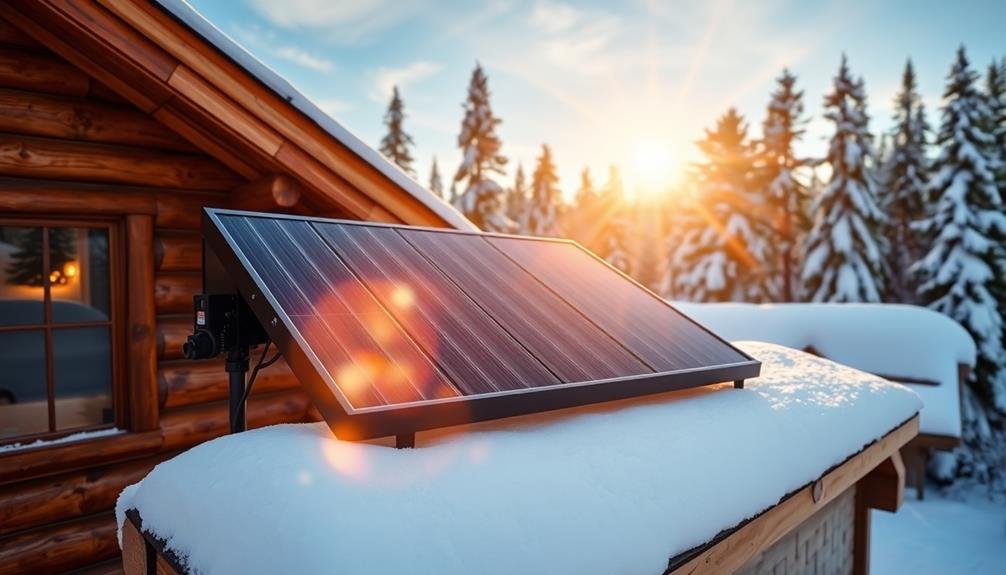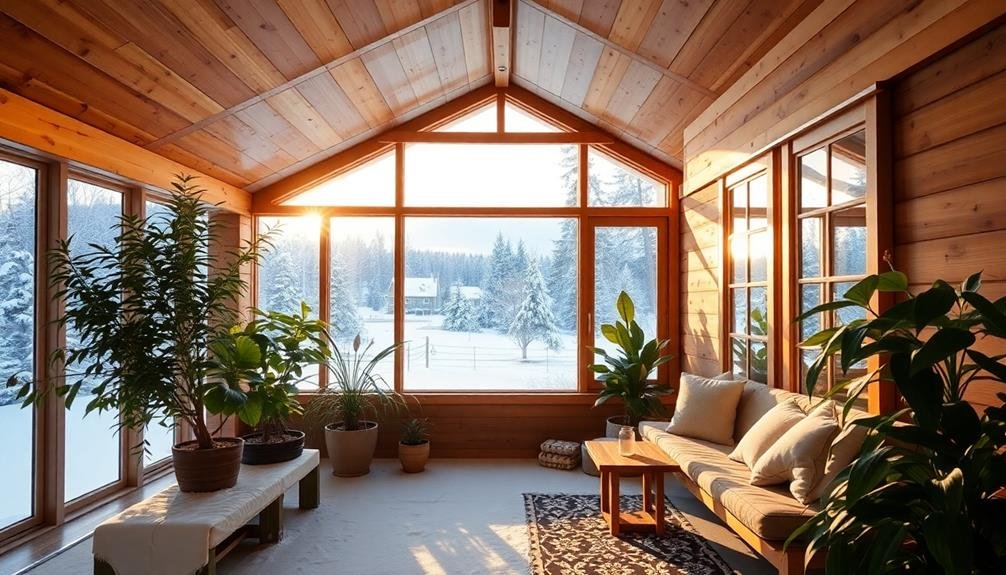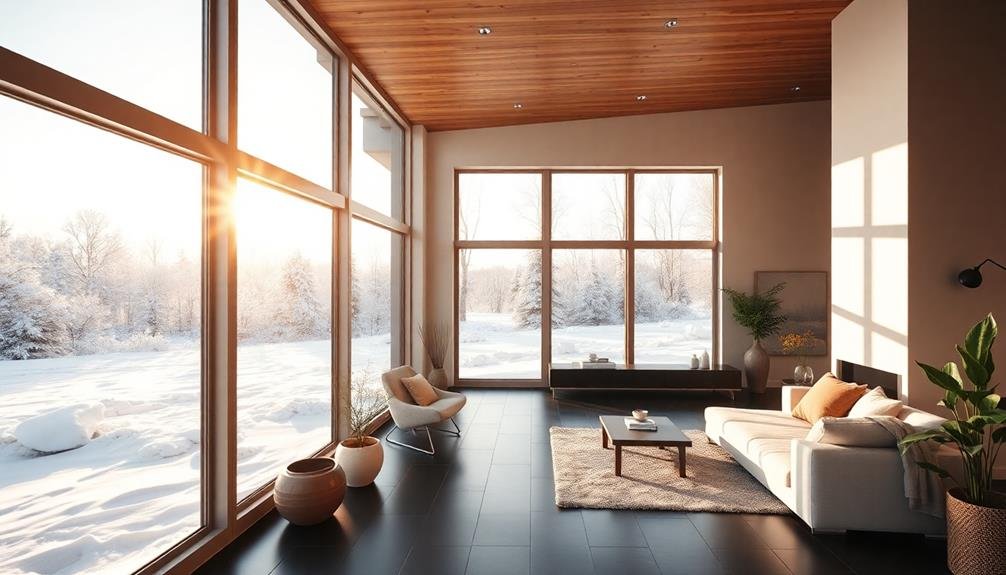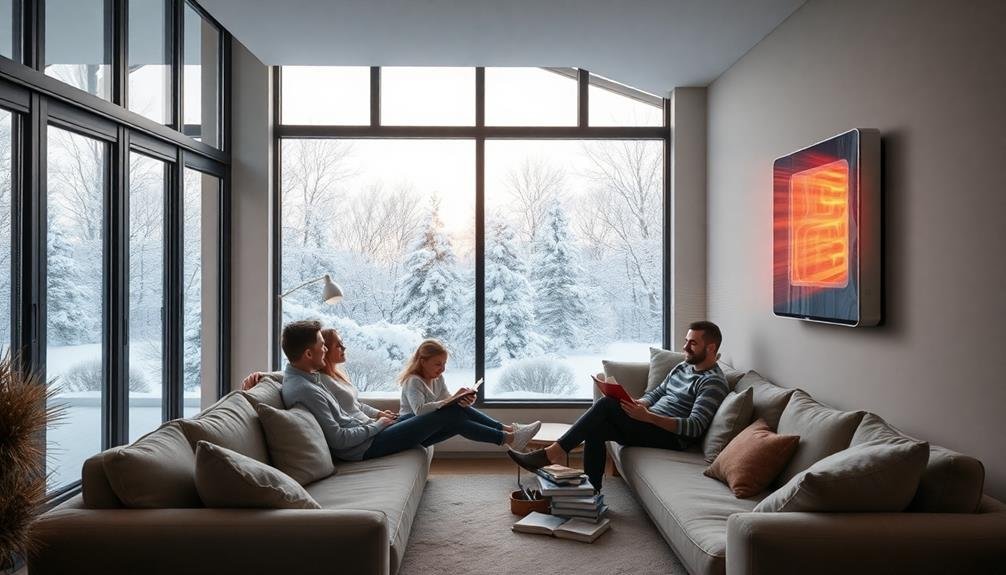Looking for efficient air heating solutions for your northern home? Consider these top options: solar air collectors, Trombe walls, sunspaces and greenhouses, transpired solar collectors, passive solar design, solar-assisted heat pumps, and photovoltaic-thermal hybrid systems. These innovative technologies harness renewable energy, reduce reliance on traditional heating methods, and enhance your home's comfort. They're designed to maximize efficiency in colder climates, offering long-term savings and eco-friendly benefits. From capturing solar energy to extending living spaces, these solutions cater to various needs and preferences. Explore these cutting-edge options to transform your northern home's heating approach.
Solar Air Collectors

Harnessing the power of the sun, solar air collectors offer an eco-friendly heating solution for northern homes. These systems consist of a dark-colored absorber plate that captures solar radiation and transfers the heat to air circulating through the collector. You'll find they're particularly effective during sunny winter days when heating demands are high.
Solar air collectors are typically mounted on south-facing walls or roofs to maximize sun exposure. They're easy to install and require minimal maintenance, making them an attractive option for homeowners. You can integrate them with your existing heating system or use them as a standalone solution for specific areas of your home.
One of the main advantages of solar air collectors is their ability to reduce your reliance on traditional heating methods, potentially lowering your energy bills. They're also silent and have no moving parts, which contributes to their longevity.
However, their effectiveness can be limited during cloudy days or at night, so you'll need a backup heating system. When considering solar air collectors, assess your home's solar potential and consult with a professional to determine the ideal size and placement for your needs.
Trombe Walls
Trombe walls offer an innovative passive solar heating solution for your northern home.
These specially designed walls absorb sunlight during the day and release heat into your living space at night, considerably reducing your energy costs.
You'll find that proper installation and minimal maintenance of Trombe walls can provide long-term heating benefits, making them an attractive option for eco-conscious homeowners.
How Trombe Walls Work
With innovative design and passive solar principles, Trombe walls offer an efficient heating solution for northern homes. These walls consist of a thick, dark-colored masonry wall facing south, with a layer of glass or plastic glazing installed a few inches in front of it. The space between the wall and glazing traps solar heat, which is then absorbed by the masonry.
Here's how Trombe walls work:
- During the day, sunlight passes through the glazing and heats the air in the gap between the glass and the wall.
- The masonry wall absorbs this heat, slowly warming up throughout the day.
- At night, the stored heat radiates into the living space, providing warmth when it's needed most.
You can enhance the efficiency of Trombe walls by adding vents at the top and bottom. These allow warm air to circulate into your home during the day and prevent reverse flow at night.
For maximum benefit, you'll want to guarantee proper sizing and placement of your Trombe wall, taking into account factors like local climate, sun angles, and your home's layout.
Energy Efficiency Benefits
Several key energy efficiency benefits make Trombe walls an attractive option for northern homeowners.
You'll find that these passive solar heating systems can greatly reduce your reliance on traditional heating methods, lowering your energy bills and carbon footprint.
Trombe walls excel at storing and distributing heat throughout your home. During sunny winter days, they absorb solar energy and slowly release it into your living spaces, providing consistent warmth even after the sun sets.
This process helps maintain a comfortable indoor temperature without constantly running your heating system.
You'll also appreciate the natural ventilation Trombe walls offer. In warmer months, you can open vents to create a cooling airflow, reducing your need for air conditioning.
Additionally, these walls act as an extra layer of insulation, further improving your home's overall energy efficiency.
Installation and Maintenance
Simplicity is key when it comes to installing Trombe walls in your northern home. You'll need to position the wall on the south-facing side of your house to maximize solar gain. The basic structure consists of a dark-colored masonry wall with a glass or plastic glazing installed a few inches in front of it. This creates an air space that traps heat, which is then slowly released into your home.
Maintenance for Trombe walls is relatively straightforward. You'll want to:
- Clean the glazing regularly to guarantee maximum sunlight penetration
- Inspect the wall for any cracks or damage that could compromise its efficiency
- Check the vents and dampers annually to guarantee proper airflow control
It's important to note that while DIY installation is possible, it's often best to consult with a professional to guarantee proper sizing and integration with your existing heating system.
They can also help you determine if additional features, such as removable summer shading or automated venting systems, would be beneficial for your specific climate and needs.
With proper installation and maintenance, your Trombe wall can provide efficient, passive solar heating for decades to come.
Sunspaces and Greenhouses

You'll find sunspaces and greenhouses to be excellent natural heat collectors for northern homes.
These additions can capture solar energy and distribute warmth throughout your living areas, reducing reliance on traditional heating systems.
Beyond their heating benefits, sunspaces and greenhouses expand your usable living space, offering a bright, inviting area to enjoy even during colder months.
Natural Heat Collection
Two natural heating solutions that harness the sun's power are sunspaces and greenhouses. These structures capture solar energy and convert it into heat, providing a cost-effective and eco-friendly way to warm your northern home.
Sunspaces, also known as solar rooms or solariums, are designed to maximize solar gain during winter months. They're typically built on the south-facing side of a house, featuring large windows that allow sunlight to penetrate and warm the space.
Greenhouses, while primarily used for growing plants, can also contribute to your home's heating. They work similarly to sunspaces but are often separate structures.
Both options offer additional benefits beyond heating:
- Increased living space for relaxation or gardening
- Improved air quality through plant photosynthesis
- Potential for year-round food production
To optimize natural heat collection, you'll need to take into account factors like your home's orientation, local climate, and seasonal sun patterns.
Proper insulation and thermal mass materials are essential for retaining collected heat. You can also incorporate fans or vents to distribute warm air throughout your home, maximizing the efficiency of these natural heating solutions.
Extending Living Spaces
Beyond their heating benefits, sunspaces and greenhouses offer an excellent opportunity to expand your living area. These additions create versatile spaces that you can use year-round, especially during the long northern winters.
Sunspaces act as buffer zones between your home's interior and the harsh outdoor environment, reducing heat loss and providing a bright, warm area for relaxation or hobbies. You'll find that sunspaces are perfect for growing plants, enjoying morning coffee, or simply basking in natural light.
Greenhouses, on the other hand, allow you to cultivate vegetables, herbs, and flowers throughout the year, extending your growing season and providing fresh produce even in winter months. Both options can considerably enhance your home's functionality and value.
When designing these spaces, consider incorporating thermal mass materials like concrete floors or water barrels to store heat during the day and release it at night.
You can also install operable windows and shading devices to regulate temperature and prevent overheating in summer. By connecting these areas to your home's heating system, you'll create a seamless shift between indoor and outdoor living, maximizing comfort and energy efficiency in your northern home.
Transpired Solar Collectors
Innovation in solar technology has led to the development of transpired solar collectors, an efficient and cost-effective heating solution for northern homes. These systems consist of perforated metal panels installed on south-facing walls, which absorb solar radiation and heat the air passing through them.
You'll find that transpired solar collectors can notably reduce your heating costs while providing a sustainable energy source.
When considering transpired solar collectors for your northern home, keep these key benefits in mind:
- Energy efficiency: They can preheat ventilation air by up to 30°C, reducing the load on your primary heating system.
- Low maintenance: With no moving parts, these collectors require minimal upkeep, ensuring long-term reliability.
- Versatility: They can be integrated into existing buildings or incorporated into new construction designs.
You'll appreciate how transpired solar collectors work seamlessly with your home's ventilation system, drawing in fresh air and heating it before it enters your living spaces.
This process not only improves indoor air quality but also helps maintain a comfortable temperature throughout your home. By harnessing the sun's energy, even in colder climates, you're making a smart investment in both your comfort and the environment.
Passive Solar Design

Passive solar design offers a natural and efficient approach to heating northern homes. It harnesses the sun's energy to warm your living spaces without relying on mechanical systems. To implement this design, you'll need to orient your home's largest windows southward, allowing maximum sunlight exposure during winter months.
You'll also want to use materials with high thermal mass, like concrete or brick, to absorb and store heat during the day and release it at night.
Proper insulation and weatherization are essential in passive solar design. You'll need to guarantee your home is well-sealed to prevent heat loss. Consider using double or triple-pane windows with low-emissivity coatings to trap heat inside.
Overhangs or awnings can be installed to block excessive summer sun while allowing winter sunlight to penetrate.
Thermal curtains or blinds can provide additional insulation at night, helping to retain the day's captured heat. You can also incorporate a sunroom or greenhouse on the south side of your home to create a buffer zone and maximize solar gain.
Solar-Assisted Heat Pumps
Solar-assisted heat pumps offer a powerful combination of renewable energy and efficient heating technology for northern homes. These systems harness the sun's energy to enhance the performance of traditional heat pumps, making them more effective in colder climates. By using solar collectors to preheat the refrigerant, solar-assisted heat pumps can operate efficiently even when outdoor temperatures drop below freezing.
You'll find that solar-assisted heat pumps have several advantages over conventional heating systems:
- Increased efficiency: They can achieve coefficients of performance (COP) up to 5, meaning they produce five times more heat energy than the electrical energy they consume.
- Lower operating costs: By leveraging solar energy, you'll reduce your reliance on grid electricity, leading to significant savings on your heating bills.
- Environmental benefits: These systems produce fewer greenhouse gas emissions compared to fossil fuel-based heating methods, helping you reduce your carbon footprint.
When considering a solar-assisted heat pump for your northern home, you'll need to factor in the initial installation costs, which can be higher than traditional systems.
However, the long-term energy savings and environmental benefits often justify the investment. You'll also want to guarantee proper sizing and installation to maximize performance in your specific climate.
Photovoltaic-Thermal Hybrid Systems

Photovoltaic-thermal (PVT) hybrid systems offer a dual-purpose solution for northern homes, combining solar electricity generation with heat production. These systems consist of photovoltaic panels with integrated thermal collectors, maximizing the use of solar energy.
In a PVT system, you'll find that the thermal component helps cool the PV cells, increasing their efficiency. This cooling effect allows the panels to generate more electricity than standard PV systems. Simultaneously, the heat absorbed by the thermal collectors is used to warm air or water for your home.
You can integrate PVT systems with your existing heating setup, such as radiant floor heating or forced-air systems. They're particularly effective when combined with heat pumps, as the pre-warmed air or water reduces the energy required for heating.
While PVT systems have higher upfront costs than separate PV and thermal systems, they offer long-term savings and increased energy efficiency. They're also space-efficient, requiring less roof area than two separate systems.
However, you'll need to evaluate factors like your home's orientation, roof space, and local climate to determine if a PVT system is right for you.
Frequently Asked Questions
How Do Air Heating Solutions Compare in Cost to Traditional Heating Systems?
You'll find air heating solutions are often more cost-effective in the long run. They're typically cheaper to install and maintain than traditional systems. However, your upfront costs may be higher, depending on the specific type you choose.
What Maintenance Is Required for These Air Heating Solutions?
You'll need to regularly clean or replace air filters, check and clean vents, and inspect ductwork. It's also important to schedule annual professional maintenance for your heating system to guarantee peak performance and efficiency.
Can These Systems Be Retrofitted to Existing Homes?
You can retrofit most air heating systems to existing homes. It'll depend on your home's layout and current infrastructure. You'll need to consult with a professional to assess feasibility, costs, and potential modifications required for installation.
How Long Do Air Heating Solutions Typically Last Before Needing Replacement?
You'll find that air heating systems typically last 15-20 years. However, you can extend their lifespan with regular maintenance. Remember, factors like usage, climate, and system quality will impact how long yours lasts before needing replacement.
Are There Government Incentives or Rebates for Installing These Heating Systems?
You'll often find government incentives for energy-efficient heating systems. Check with your local and state agencies for available rebates. They're typically offered for heat pumps, high-efficiency furnaces, and other eco-friendly options. Don't miss out on potential savings!
In Summary
You've now explored seven innovative air heating solutions perfect for northern homes. From passive solar designs to high-tech hybrid systems, there's an option to suit your needs and budget. By implementing one or more of these eco-friendly methods, you'll reduce your carbon footprint and save on energy costs. Don't let the cold climate deter you; embrace these smart heating alternatives and stay warm while being kind to the environment.





Leave a Reply